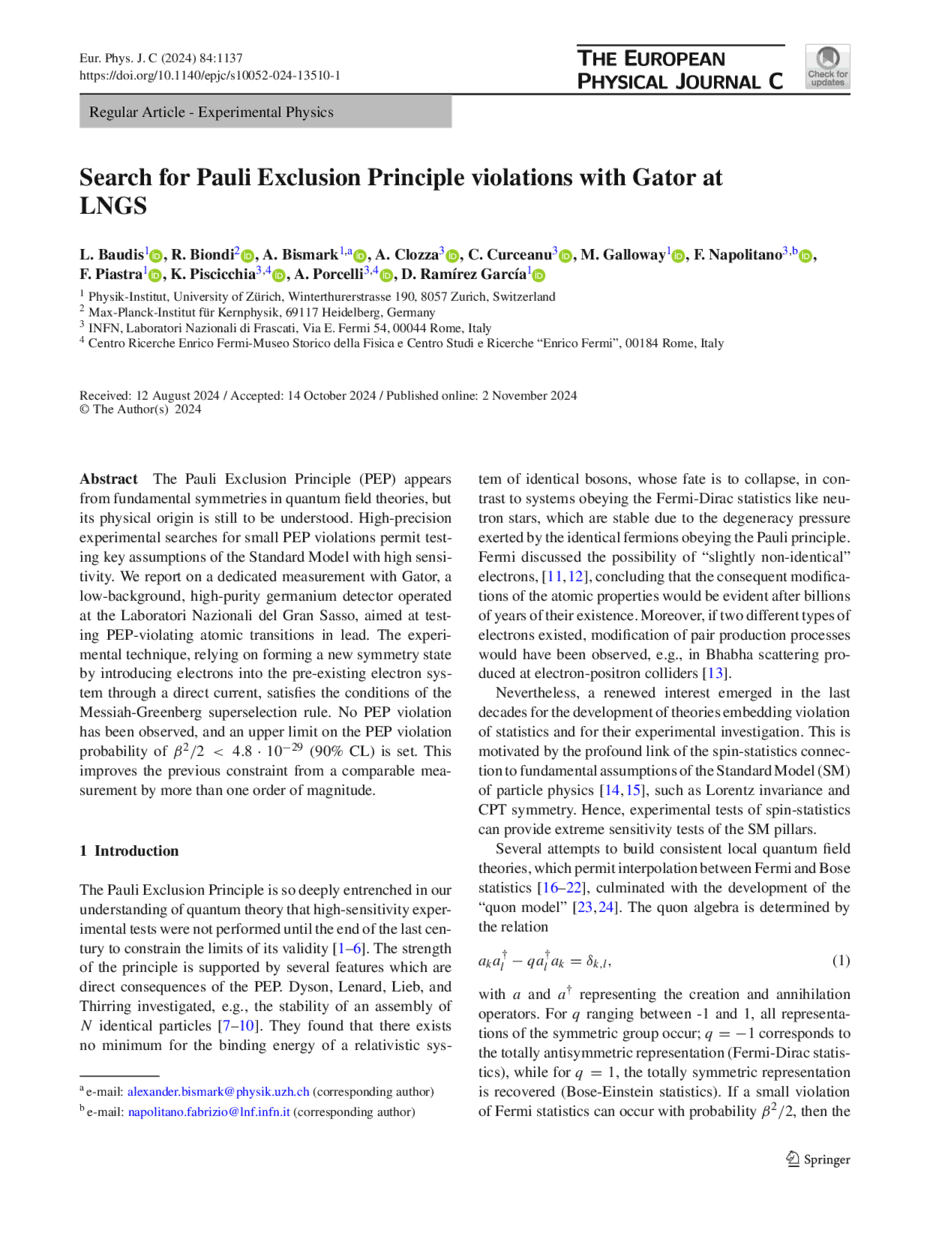https://doi.org/10.1140/epjc/s10052-024-13510-1
Regular Article - Experimental Physics
Search for Pauli Exclusion Principle violations with Gator at LNGS
1
Physik-Institut, University of Zürich, Winterthurerstrasse 190, 8057, Zurich, Switzerland
2
Max-Planck-Institut für Kernphysik, 69117, Heidelberg, Germany
3
INFN, Laboratori Nazionali di Frascati, Via E. Fermi 54, 00044, Rome, Italy
4
Centro Ricerche Enrico Fermi-Museo Storico della Fisica e Centro Studi e Ricerche “Enrico Fermi”, 00184, Rome, Italy
a
alexander.bismark@physik.uzh.ch
b
napolitano.fabrizio@lnf.infn.it
Received:
12
August
2024
Accepted:
14
October
2024
Published online:
2
November
2024
The Pauli Exclusion Principle (PEP) appears from fundamental symmetries in quantum field theories, but its physical origin is still to be understood. High-precision experimental searches for small PEP violations permit testing key assumptions of the Standard Model with high sensitivity. We report on a dedicated measurement with Gator, a low-background, high-purity germanium detector operated at the Laboratori Nazionali del Gran Sasso, aimed at testing PEP-violating atomic transitions in lead. The experimental technique, relying on forming a new symmetry state by introducing electrons into the pre-existing electron system through a direct current, satisfies the conditions of the Messiah-Greenberg superselection rule. No PEP violation has been observed, and an upper limit on the PEP violation probability of  (90% CL) is set. This improves the previous constraint from a comparable measurement by more than one order of magnitude.
(90% CL) is set. This improves the previous constraint from a comparable measurement by more than one order of magnitude.
© The Author(s) 2024
 Open Access This article is licensed under a Creative Commons Attribution 4.0 International License, which permits use, sharing, adaptation, distribution and reproduction in any medium or format, as long as you give appropriate credit to the original author(s) and the source, provide a link to the Creative Commons licence, and indicate if changes were made. The images or other third party material in this article are included in the article’s Creative Commons licence, unless indicated otherwise in a credit line to the material. If material is not included in the article’s Creative Commons licence and your intended use is not permitted by statutory regulation or exceeds the permitted use, you will need to obtain permission directly from the copyright holder. To view a copy of this licence, visit http://creativecommons.org/licenses/by/4.0/.
Open Access This article is licensed under a Creative Commons Attribution 4.0 International License, which permits use, sharing, adaptation, distribution and reproduction in any medium or format, as long as you give appropriate credit to the original author(s) and the source, provide a link to the Creative Commons licence, and indicate if changes were made. The images or other third party material in this article are included in the article’s Creative Commons licence, unless indicated otherwise in a credit line to the material. If material is not included in the article’s Creative Commons licence and your intended use is not permitted by statutory regulation or exceeds the permitted use, you will need to obtain permission directly from the copyright holder. To view a copy of this licence, visit http://creativecommons.org/licenses/by/4.0/.
Funded by SCOAP3.





